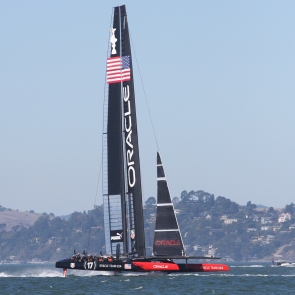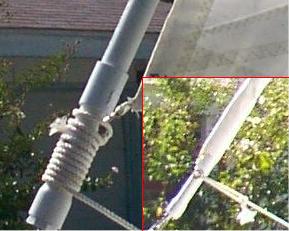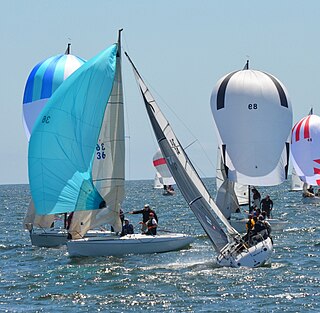
Sail twist is a phenomenon in sailing where the head of the sail is at a different angle of incidence from the foot of the sail in order to change the lift distribution with height. Twist is measured by comparing the angle of a straight line between the leading edge (luff) and trailing edge (leech) with that of the boom. [1] Some twist is desirable, but too much can induce weather helm or ruin the slot between the mainsail and jib. [2]

Sailing employs the wind—acting on sails, wingsails or kites—to propel a craft on the surface of the water, on ice (iceboat) or on land over a chosen course, which is often part of a larger plan of navigation.

On fixed-wing aircraft, the angle of incidence is the angle between the chord line of the wing where the wing is mounted to the fuselage, and a reference axis along the fuselage. The angle of incidence is fixed in the design of the aircraft, and with rare exceptions, cannot be varied in flight.

In sailing, a boom is a spar (pole), along the foot of a fore and aft rigged sail, that greatly improves control of the angle and shape of the sail. The primary action of the boom is to keep the foot flatter when the sail angle is away from the centerline of the boat. The boom also serves as an attachment point for more sophisticated control lines. Because of the improved sail control it is rare to find a non-headsail without a boom, but lateen sails, for instance, are loose-footed. In some modern applications, the sail is rolled up into the boom for storage or reefing.
Three sail shape controls which control the leech tension, and therefore sail twist, are the mainsheet, the boom vang and the traveler. [3] The mainsheet pulls the boom (and therefore the foot of the sail) primarily inwards at lower points of sail and downwards at higher points of sail. Manipulation of the traveler can counteract this because it always pulls the boom laterally. The vang on the other hand does the opposite, it always changes the height of the boom.

A boom vang (US) or kicking strap (UK) is a line or piston system on a sailboat used to exert downward force on the boom and thus control the shape of the sail. The Collins English Dictionary defines it as "A rope or tackle extended from the boom of a fore-and-aft mainsail to a deck fitting of a vessel when running, in order to keep the boom from riding up".

A mechanical traveller is a moving part of a machine, typically a ring that slides between different positions on a supporting rod when the machine goes through its operating cycle. The term may also be used refer to the supporting rod.
Computer cut sails can produce the amount of twist specified by the sailmaker, and in different conditions, different amounts of twist may be desirable. Less twist is generally desirable in light air conditions and slackening the luff tension will tighten the leech of the sail. This moves the center of effort on the sail toward the trailing edge and reduces twist thus making the sail more powerful but vulnerable to stalling.

A sailmaker makes and repairs sails for sailboats, kites, hang gliders, wind art, architectural sails, or other structures using sails. A sailmaker typically works on shore in a sail loft; the sail loft has other sailmakers. Large ocean-going sailing ships often had sailmakers in the crew. The sailmaker maintained and repaired sails. This required knowledge of the sailmaker's craft and the tools of the sailmakers loft on shore.












